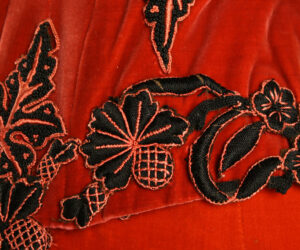
Mourning Traditions and Fashion History
1 – What lurks in the shadows this evening? Why, it's #ThreadTalk! And we're going full mourning.
Continuing our theme of #Halloween 🦇, we'll look at the fashion of grief in history, expose some myths, & of course, examine those super extra Victorians.🕸️
CW: death, etc.
2 – For most Westerners, black is synonymous with death & mourning, but that's largely a Victorian PR push (more on that later).
Funerary goods show motifs, like this Greek example, often with mourners along with the deceased, dating from the 6th C BCE.

3 – White is largely the color of mourning in many cultures, including Japan, India, & beyond. And was in many medieval European countries.
Mary, Queen of Scots, famously wore "en deuil blanc" or "white mourning" in 1559 when her father-in-Law, Henri II of France died.

4 – Which is not to say that black was never worn. But it was *incredibly* expensive. So, for an average layperson, attaining a rich black outfit was very unlikely, let alone more than one.
But if you were a Medici, like Marie here in 1616, it was no biggie. TONS of fabric.

5 – For me, this makes sense as we move from medieval to Early Modern & art explodes across Europe.
One of the most popular themes of the age is the Lamentation of Christ, featuring both the Virgin & Mary Magdalene mourning (Botticelli, 1508-10). Even now, it's moving.
![From Wikipedia: The painting depicts the lamentation (expression of great sorrow or deep sadness) [2] over Christ's death. The Virgin Mary sits vertically with the dead Christ on her lap, his body appearing extremely small. The positioning of the two bodies creates the Pieta, which means pity in Italian and is a representation of The Virgin Mary mourning dead Christ.[3] The Three Maries are circling the inner group expressing despair. Mary Magdalen is positioned at the feet of Christ in turmoil. St.John sits above The Virgin Mary and cradles her head in an attempt to soothe her. Joseph of Arimathea stands above the group holding the crown of thorns and three nails. Botticelli paints the figures in contorted and distorted poses. He does not apply the rules of naturalism to the painting. Instead, he focuses on his own personal preference of geometry.[4] This very style of geometry had an influence on third generation renaissance painters to come.](https://pbs.twimg.com/media/FBdVqd6WEAw1N28.jpg)
6 – In this context, & in the Classical resurgence as well, women are given space to do something heroic: mourning is a superpower.
Women are brightly dressed in relatively contemporary dresses in blues, greens, reds; veiled & unveiled. Expressive, attentive. (Solario, 1509)

7 – This comes from a long tradition. Death has a strange history in Europe, often dancing alongside the living.
Death art incorporated skeletons everywhere. Both seriously and rather humorous (humerous?). Below, from St. Nicholas' Church, Estonia 15th C.

8 – The idea of "memento mori" or "remember death" — the idea that we all must die, was wicked popular, too. Proto goth kids, basically.
This pendant is two-sided & dates from 1500. The peaceful front conceals a skeleton covered with slugs & worms reading, "Alas, I must die."
9 – And of course, remembering death was a big deal for Christian saints, too. Preserving any bit of any saint was big business (even if they weren't exactly *authenticated*).
My personal favorite is St. Foi, from France, who died in the 3rd century. Her remains lie within. 👀

10 – Okay, so yes, mourning garb was a thing before Queen Victoria, but when Albert died in 1861, it was a matter of incredible fashion timing.
Victoria went into permanent mourning. End stop. She even walked her daughters down the aisle in full deep black. Beatrice, below, 1885
11 – The 19th century saw huge advancements in dyes, & black was among them. Aniline, among other chemicals, meant that black well-to-do women could commission entire wardrobes of mourning garments.
No longer stodgy widows weeds, eh? This 1860s gown also has Chantilly lace <3
12 – Mourning rules varied, but women held the most responsibility.
Deep mourning meant all black, representing grief, piety, purity, etc. Saved typically for wives, mothers, of deceased.
Fabrics were dull (no satin or) & the period could last 9 mo-1 year plus. 1840s, below.
13 – Ordinary mourning introduced trimmings: satin, jet beads, and other bits of embroidery or accessories.
This jet-encrusted stunner is like… a lot. In a good way. But its owner clearly had $$$. Closeup on those buttons. Jet is traditionally associated with mourning, too.
14 – Jet jewelry has been thing for centuries, but by the 1850s, it was a powerhouse for the big business of mourning.
It's the fossilized bits of old driftwood, which is goth AF. And honestly, I'm a bit obsessed with it? Can has?
This depiction is of "Night" as a lady. <3

15 – Half-mourning allowed a slow return to color, including shades of purple, lilac, grey, & black and white.
Fur, and other sumptuous fabrics, also return, like in this half-mourning jacket (1880s) from the V&A. Midnight blue, in this case, is close enough to purple?

Originally tweeted by 🦇 Natania Barron 🦇 (@NataniaBarron) on October 11, 2021.
1 – What lurks in the shadows this evening? Why, it's #ThreadTalk! And we're going full mourning.
Continuing our theme of #Halloween 🦇, we'll look at the fashion of grief in history, expose some myths, & of course, examine those super extra Victorians.🕸️
CW: death, etc.
2 – For most Westerners, black is synonymous with death & mourning, but that's largely a Victorian PR push (more on that later).
Funerary goods show motifs, like this Greek example, often with mourners along with the deceased, dating from the 6th C BCE.

3 – White is largely the color of mourning in many cultures, including Japan, India, & beyond. And was in many medieval European countries.
Mary, Queen of Scots, famously wore "en deuil blanc" or "white mourning" in 1559 when her father-in-Law, Henri II of France died.

4 – Which is not to say that black was never worn. But it was *incredibly* expensive. So, for an average layperson, attaining a rich black outfit was very unlikely, let alone more than one.
But if you were a Medici, like Marie here in 1616, it was no biggie. TONS of fabric.

5 – For me, this makes sense as we move from medieval to Early Modern & art explodes across Europe.
One of the most popular themes of the age is the Lamentation of Christ, featuring both the Virgin & Mary Magdalene mourning (Botticelli, 1508-10). Even now, it's moving.
![From Wikipedia: The painting depicts the lamentation (expression of great sorrow or deep sadness) [2] over Christ's death. The Virgin Mary sits vertically with the dead Christ on her lap, his body appearing extremely small. The positioning of the two bodies creates the Pieta, which means pity in Italian and is a representation of The Virgin Mary mourning dead Christ.[3] The Three Maries are circling the inner group expressing despair. Mary Magdalen is positioned at the feet of Christ in turmoil. St.John sits above The Virgin Mary and cradles her head in an attempt to soothe her. Joseph of Arimathea stands above the group holding the crown of thorns and three nails. Botticelli paints the figures in contorted and distorted poses. He does not apply the rules of naturalism to the painting. Instead, he focuses on his own personal preference of geometry.[4] This very style of geometry had an influence on third generation renaissance painters to come.](https://pbs.twimg.com/media/FBdVqd6WEAw1N28.jpg)
6 – In this context, & in the Classical resurgence as well, women are given space to do something heroic: mourning is a superpower.
Women are brightly dressed in relatively contemporary dresses in blues, greens, reds; veiled & unveiled. Expressive, attentive. (Solario, 1509)

7 – This comes from a long tradition. Death has a strange history in Europe, often dancing alongside the living.
Death art incorporated skeletons everywhere. Both seriously and rather humorous (humerous?). Below, from St. Nicholas' Church, Estonia 15th C.

8 – The idea of "memento mori" or "remember death" — the idea that we all must die, was wicked popular, too. Proto goth kids, basically.
This pendant is two-sided & dates from 1500. The peaceful front conceals a skeleton covered with slugs & worms reading, "Alas, I must die."
9 – And of course, remembering death was a big deal for Christian saints, too. Preserving any bit of any saint was big business (even if they weren't exactly *authenticated*).
My personal favorite is St. Foi, from France, who died in the 3rd century. Her remains lie within. 👀

10 – Okay, so yes, mourning garb was a thing before Queen Victoria, but when Albert died in 1861, it was a matter of incredible fashion timing.
Victoria went into permanent mourning. End stop. She even walked her daughters down the aisle in full deep black. Beatrice, below, 1885
11 – The 19th century saw huge advancements in dyes, & black was among them. Aniline, among other chemicals, meant that black well-to-do women could commission entire wardrobes of mourning garments.
No longer stodgy widows weeds, eh? This 1860s gown also has Chantilly lace <3
12 – Mourning rules varied, but women held the most responsibility.
Deep mourning meant all black, representing grief, piety, purity, etc. Saved typically for wives, mothers, of deceased.
Fabrics were dull (no satin or) & the period could last 9 mo-1 year plus. 1840s, below.
13 – Ordinary mourning introduced trimmings: satin, jet beads, and other bits of embroidery or accessories.
This jet-encrusted stunner is like… a lot. In a good way. But its owner clearly had $$$. Closeup on those buttons. Jet is traditionally associated with mourning, too.
15 (b)- Of course, men had some mourning to do, but it was limited. Mostly relegated to arm-bands, or small bits of jewelry, they were not held to such long, drawn-out customs.
Oddly enough, the practice of black arm bands goes way back… See Catherine Howard, ca. 1618.

16 – Another half-mourning gown I think is the business is this one here. Purple and black are one of my all-time favorite combinations.
The whole ensemble, from the jet necklace to the little hairwork brooch.
OH WAIT.
::record scratch::
Time to talk about hairwork.

17 – The natural extension (snort) was clipping hair off the dead. Then, of course, making art of it.
Boy howdy did the Victorians get creative with it.
Here's a fun throwback to earlier in the thread. This locket, front & back. Yes, that's human hair. "I alone can heal."
18 – Then, this mourning artisan in 1840 was just like… well how about we just make the whole entire ring out of hair. Because that's what I want to feel.
Hair.
On my fingers.
On my skin. All the time.
Also, let's make two of them.

19 – "BUT NATANIA," you ask! "What about tear catchers?"
I'm really, really sorry to break it you all. But are a grand fiction. As absolutely ridiculous as the Victorians were, what we think of as tear catchers are, in fact, just perfume bottles.

20 – Okay, so let's get to some dresses, shall we?
I never imagined writing these words but: CHINTZ and MOURNING. The garment is called a wentke, & was popular in Holland. These gowns were typically super bright colored. But this monochrome is still stunning. ca early 18th C.

21 – Help. I'm in love. Jet and satin? These hips do not lie. Emile Pingat, from 1877-1880. Can't tell if it's officially mourning, but it does make me want to cry.
Excuse me, madam. I think I need a drink.

22 – Some half-mourning for you in this number, which has a lovely bit of ruffle, and a rather fun square neck going on. This is ca. 1872-74, and I really love the contrasting cream and lace combination. The bustle also ties up, which is practical, yeah?

23 – Couldn't look myself in the face tomorrow if we didn't cover Worth, & this deep blue/black velvet VOID from 1896 is about as deathly dramatic as you can get. Nothing like silk velvet to just literally suck away all light and remind you that life is fleeting. And expensive.

24 – 1887 is one of my favorite years, and this dress does not disappoint. This ensemble says, "I had absolutely nothing to do with my husband's most untimely demise. How could you ever suspect a thing? I am beside myself with grief."
I mean, that neckline. With the lace.

25 – Accessories, though. If you want a bit of lace drama in your life, I would recommend this half-mourning cape with a purple lining.
Silk crepe, it looks like, and plenty of lace. You would look like a villain–vision, I mean, wherever you were. Abraham & Straus, 1900.

26 – And lastly, *that dress* that was floating around Twitter last week.
Yes, it's a half-mourning dress!
It's from the V&A. Almost looks like mummy wrapping… Figured silk & chiffon, machine-made lace, dating to 1889-1892, Paris. Worn by either Anne or Cara Rogers.
27 – There's so much more on this topic, but alas, it's time for sources…
Ancient Greece:
https://www.metmuseum.org/toah/hd/dbag/hd_dbag.htm
Mary Queen of Scots:
https://www.rct.uk/collection/403429/mary-queen-of-scots-1542-87
On the Color Black:
https://refashioningrenaissance.eu/exploring-historical-blacks-the-burgundian-black-collaboratory/
Memento Mori:
28 – Sources 2
Victorian Mourning:
https://www.thefrickpittsburgh.org/Story-Memory-and-Mourning-Death-in-the-Gilded-Age
http://england.prm.ox.ac.uk/englishness-funeral-clothing.html
Prince Albert's Death:
https://www.pbs.org/newshour/health/156-years-after-prince-alberts-death-we-still-dont-know-exactly-why-he-died
History of Hair:
https://cmsmc.org/publications/performativity-of-mourning-jewellery
https://uh-ir.tdl.org/bitstream/handle/10657/3003/Harmeyer.pdf?sequence=1&isAllowed=y
Tear catchers:
https://www.atlasobscura.com/articles/tearcatchers-victorian-myth-bottle
29 – Thanks for joining me on tonight's #threadtalk! I hope you enjoyed a look how fashion can help us through grief, or just make things more complicated…
Next week, we'll have more #Halloween haunting! 🎃
(And I do have a tip jar — since many have asked — in my bio 🦇)
Originally tweeted by 🦇 Natania Barron 🦇 (@NataniaBarron) on October 11, 2021.








![From Wikipedia: On the event of her wedding to Prince Henry of Battenberg at Saint Mildred's Church at Whippingham, near Osborne, on 23 July 1885, Princess Beatrice of the United Kingdom wore a wedding dress of white satin, trimmed with orange blossom and lace,[1] the lace overskirt held by bouquets of the blossom entwined with white heather. There was lace on the pointed neck line, and on the sleeves, for the Princess was a lover of, and an expert on, lace. One of her most treasured possessions was a tunic of old point d'Alençon which had belonged to Catherine of Aragon. Knowing her daughter's love of lace, the Queen allowed Princess Beatrice to wear the Honiton lace and veil which she herself had worn on her wedding day. It was a very precious possession to the Queen, and Princess Beatrice was the only one of her daughters to be given the opportunity to wear it.[1] Her veil was emblazoned with a diamond circlet with diamond stars, a wedding gift from her mothe](https://pbs.twimg.com/media/FBdiGLlWUAQEssS.jpg)












